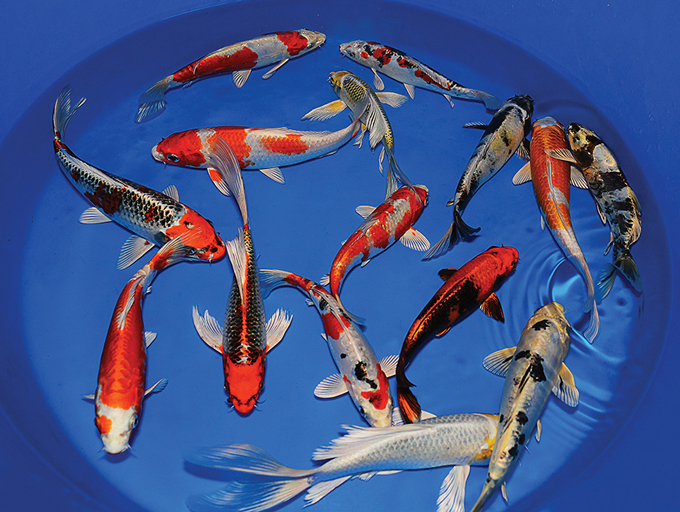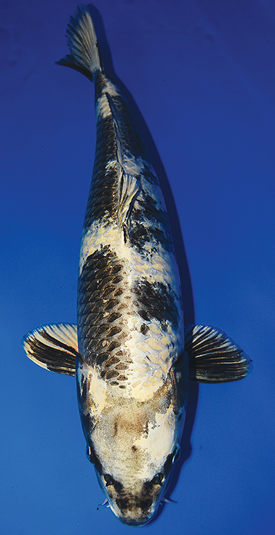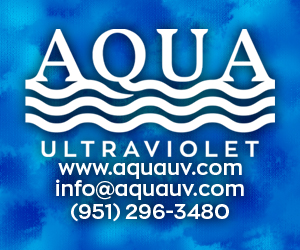
In the previous installment of Language of Koi, we learned how to distinguish between metallic and non-metallic skin on koi, as well as how to identify the characteristic known as luster. We also explored the single-colored, metallic-skinned koi in the Hikari Muji class.
Now we will study the other two Hikari classes of koi, Hikari Utsuri and Hikari Moyo. The fish in these groups display more than one color and will have a pattern or markings, all in combination with a metallic base. The fact that they have shiny, metallic skin should be understood, as their classification begins with the Japanese word for shining, hikari.
Hikari Utsuri Class
The fish in the Hikari Utsuri class are multi-colored, metallic-skinned koi that are of Utsuri lineage. They are generally fully scaled, but they can be found in Doitsu type, as well as with long fins (butterfly). They will have heavy-banded patterns comparable to the traditional Utsuri and Showa patterns. Basically you’ll see metallic Showa and Utsuri in this group (though not ginrin scales — that’s a separate classification). Because each koi is of Utsuri bloodline, one color is always black, or sumi. It will have two colors, so you may find them in several color combinations, such as black and white, black and red or black and yellow. If it is a three-colored fish, you’ll see black, red and white. Each version has a specific Japanese name.
- Gin Shiro Utsuri: metallic Shiro Utsuri, two colors (black and white)
- Kin Ki Utsuri: metallic Ki Utsuri, two colors (black and yellow)
- Kin Hi Utsuri: metallic Hi Utsuri, two colors (black and red)
- Kin Showa: metallic Showa, three colors (black, red and white)
The patterns of Hikari Utsuri koi generally parallel those of the traditional Utsuri and Showa — thick bands or patches of color. Ideally, the bands should be evenly spaced along the body from nose to tail. The large patches of color often connect with each other and wrap around the fish down to the belly. The substantial block-like patterns are very impressive on glistening, metallic skin. In the Japanese language, the word utsuri means reflection. Reflection refers to the formation of the pattern, or the way the two colors alternate to mimic a checkerboard, each color the opposite of the previous color. The Hikari Utsuri pattern is graded with the same principles as their non-metallic counterparts, with balance being very important.

Another aspect of Hikari Utsuri varieties is the occurrence of sumi on the fins, although not every fish will display this trait. Most noteworthy is motogoro, or sumi located at the base of the pectoral fins. Some varieties in the Hikari Utsuri class will have sumi stripes on the pectoral fins rather than a patch of sumi on the pectoral joint. Hikari Utsuri varieties are also produced with long, butterfly fins.
To correctly identify your koi in the Hikari Utsuri class, verify that it has metallic skin, multiple colors (one being black) and a pattern. Its pattern will be displayed as large connecting bands of color that wrap around the body, and perhaps black pigment will be apparent on the fins.
Hikari Moyo Class

Finally, we come to the Hikari Moyo class. The fish in this class are multi-colored, metallic-skinned koi that display a pattern, though are not of Utsuri lineage.
Just like the previous two groups, the class name begins with the word Hikari, so the koi in this class will have beautiful, iridescent metallic skin, too. Each will have two or more colors, and every koi will have a pattern. The word moyo means pattern, design or marking. However, there are no checkerboard patterns in this class, because these koi are not of Utsuri lineage.
Each koi in the Hikari Moyo class has a bright, metallic, platinum base color. All will have at least one complementary color. Some varieties will have two, three and or even four colors. These additional pigments form interesting patterns. Like the varieties in the Hikari Utsuri class, the colors are often muted or diffused because of the strong metallic quality of the underlying skin. Generally, beni is slightly transparent, so it appears as a beautiful, golden-orange color on top of the platinum base. The black shows up as a light-charcoal gray.
Because they are in the Hikari class, the luster is harshly judged in this group, too. Again, a glistening sheen should cover the entire body of the koi and spread all the way to the tips of the fins. Generally, the koi in the Hikari Moyo class will have flashy, white pectoral fins that accentuate the pattern. These impressive pectorals can be spotted easily, even in ponds with tepid or somewhat cloudy water conditions.
One highly sought-after koi in this class is the Kujaku. It has a platinum base color with significant red markings. Its scales have dark-colored overlay centers, or pinecone patterns. This is called reticulation. Being of Hikari type, the red on Kujaku is often transformed into a dazzling, bright orange. That, together with dramatic contrasts between a platinum base and the dark scale centers, produces a radiant effect.

Pattern is generally random in this class and may be compared to the patterns of non-metallic varieties, such as Kohaku, Sanke and Bekko. Many koi hobbyists are drawn to the fish of this class because of their brilliant, shiny base, wide range of colors and extensive pattern possibilities. The Hikari Moyo class contains many unusual and uncommon metallic varieties. Some are scaled, some are Doitsu type and some are produced with butterfly fins. Many are thought of as rare or exotic.
• Hariwake: platinum koi with orange or yellow pattern
• Yamatonishiki: metallic Sanke, platinum base with red pattern and black spots
• Kujaku: platinum base with reticulation on scales and orange or red pattern
• Kikusui: platinum koi with red pattern, always Doitsu (no scales)
• Gin Bekko: metallic Bekko, platinum koi with black spots
To determine whether your koi belongs in the Hikari Moyo group, verify that it has a clean, bright, platinum base color with at least one additional color, while displaying a pattern that is not an Utsuri (checkerboard) style.
By using this information, you can easily identify your favorite metallic koi variety and determine in which Hikari class it belongs.
>> For more help with koi identification, and to see our illustrations of many koi varieties, visit our www.kloubeckoi.com/ellens-koi-education


